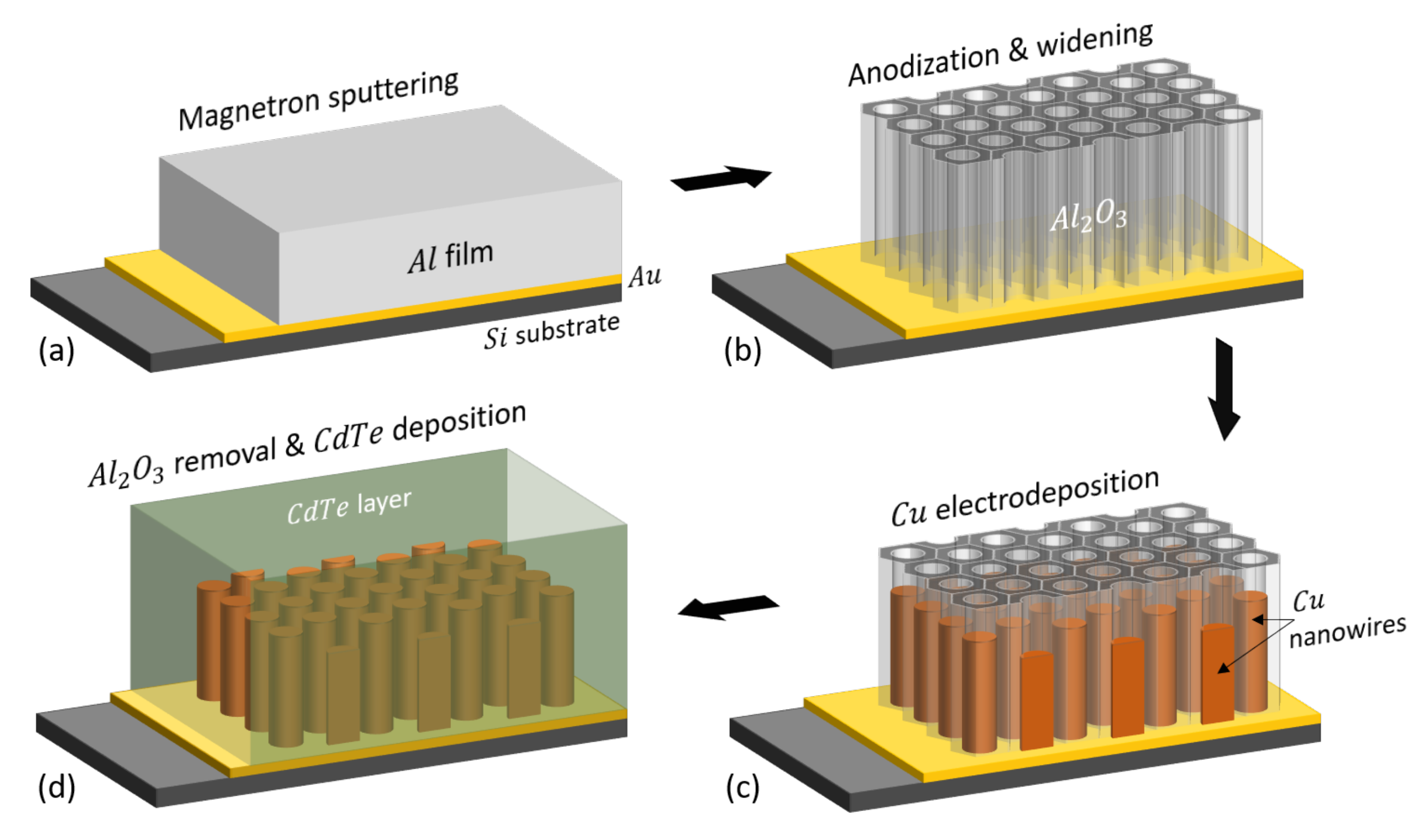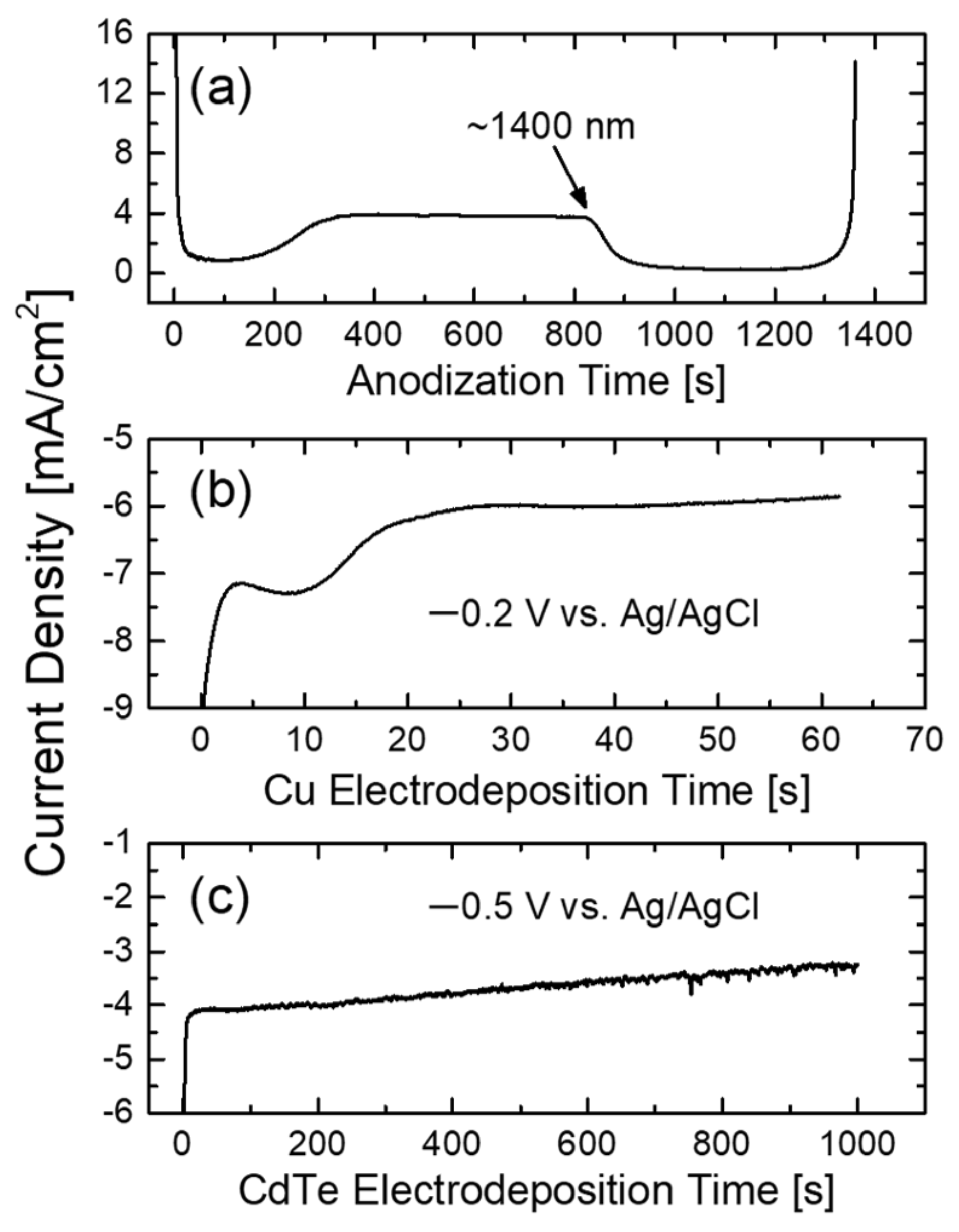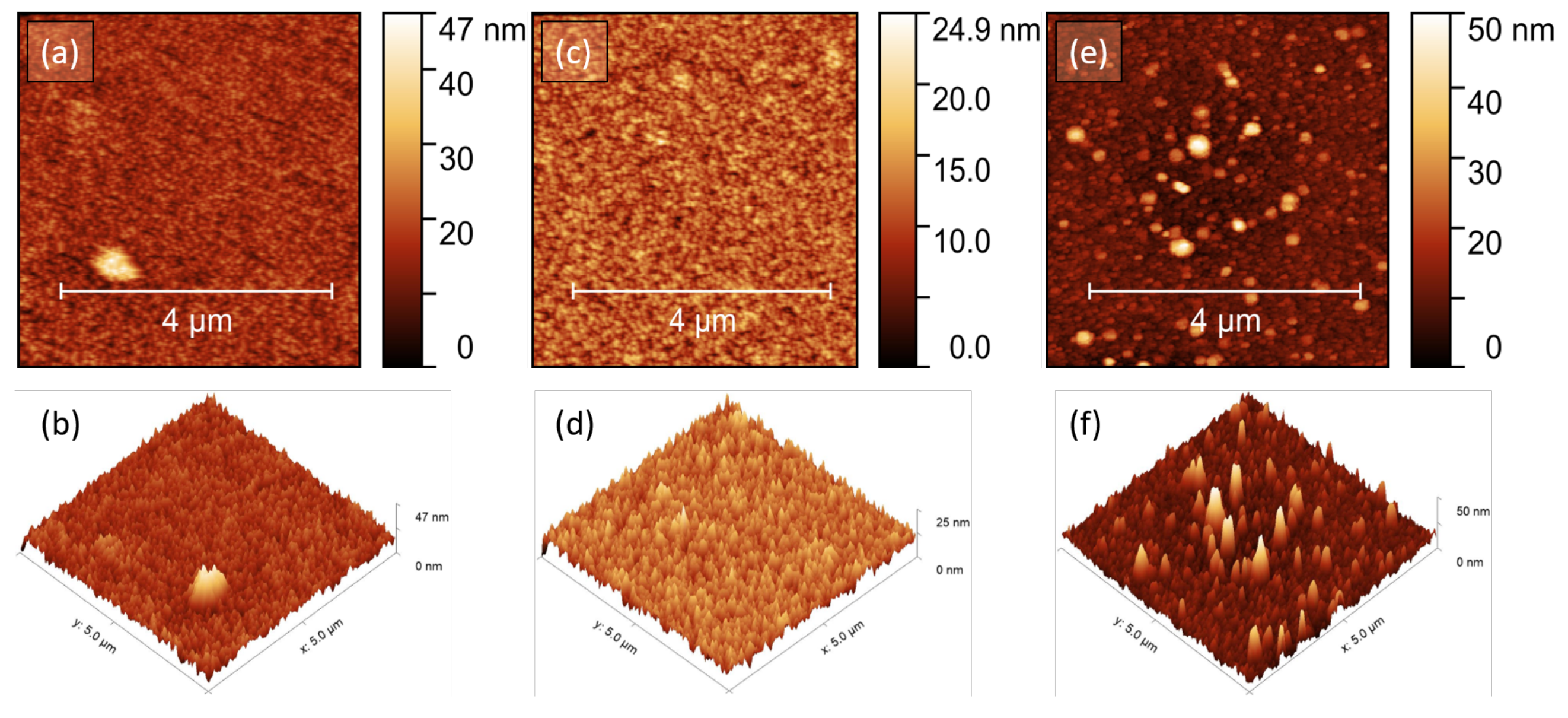Effect of the Cadmium Telluride Deposition Method on the Covering Degree of Electrodes Based on Copper Nanowire Arrays
Abstract
:1. Introduction
2. Materials and Methods
2.1. Sample Preparation
2.2. Sample Characterization
3. Results and Discussion
3.1. Morphological Characterizations
3.2. Structural Characterization
3.3. Optical Characterization
4. Conclusions
Author Contributions
Funding
Institutional Review Board Statement
Informed Consent Statement
Data Availability Statement
Acknowledgments
Conflicts of Interest
Abbreviations
| MDPI | Multidisciplinary Digital Publishing Institute |
| Appl. Sci. | Applied Sciences |
| R&D | Research & Development |
| MDEO | R&D Center for Materials and Electronic & Optoelectronic Devices |
| INFLPR | National Institute for Lasers, Plasma and Radiation Physics |
| NIMP | National Institute of Materials Physics |
| AOSR | Academy of Romanian Scientists |
| UCLouvain | Université catholique de Louvain |
| IMCN | Institute of Condensed Matter and Nanosciences |
| IMT | National Institute for R&D in Microtechnologies |
| NWs | Nanowires |
| PC | Polycarbonate |
| AAO | Anodic aluminum oxide |
| VTE | Vacuum thermal evaporation |
| RF-MS | Radio frequency-magnetron sputtering |
| ECD | Electrochemical deposition |
| PCE | Power conversion efficiency |
| 1D | One-dimensional |
| DIW | Deionized water |
| DC | Direct current |
| SE | Standard error |
| NHE | Normal hydrogen electrode |
| SEM | Scanning Electron Microscope |
| AFM | Atomic Force Microscope |
| RMS | Route means square roughness |
| Ssk | Skewness |
| K | Excess Kurtosis |
| XRD | X-ray diffraction |
| UV-VIS | Ultraviolet - Visible |
| UEFISCDI | Executive Unit for Financing Higher Education, Research, Development and Innovation |
| FNRS | Fonds de la Recherche Scientifique |
| BSMA | Bio- and Soft Matter |
References
- Toma, O.; Antohe, V.A.; Panaitescu, A.M.; Iftimie, S.; Răduţă, A.M.; Radu, A.; Ion, L.; Antohe, Ş. Effect of RF Power on the Physical Properties of Sputtered ZnSe Nanostructured Thin Films for Photovoltaic Applications. Nanomaterials 2021, 11, 2841. [Google Scholar] [CrossRef] [PubMed]
- Manica, D.; Antohe, V.A.; Moldovan, A.; Pascu, R.; Iftimie, S.; Ion, L.; Suchea, M.P.; Antohe, Ş. Thickness Effect on Some Physical Properties of RF Sputtered ZnTe Thin Films for Potential Photovoltaic Applications. Nanomaterials 2021, 11, 2286. [Google Scholar] [CrossRef] [PubMed]
- Ion, L.; Iftimie, S.; Radu, A.; Antohe, V.A.; Toma, O.; Antohe, Ş. Physical Properties of RF-Sputtered ZnSe Thin Films for Photovoltaic Applications: Influence of Film Thickness. Proc. Rom. Acad. Ser. A 2021, 22, 25–34. [Google Scholar]
- Wald, F.V. Applications of CdTe. A review. Rev. Phys. Appl. 1977, 12, 277–290. [Google Scholar] [CrossRef]
- Bottger, G.L.; Geddes, A.L. Infrared Absorption Spectrum of CdTe. J. Chem. Phys. 1967, 47, 4858–4859. [Google Scholar] [CrossRef]
- Kiefer, J.E.; Yariv, A. Electro-Optic Characteristics of CdTe at 3.39 and 10.6 μ. Appl. Phys. Lett. 1969, 15, 26–27. [Google Scholar] [CrossRef]
- Morikawa, K.; Yamaka, E. Electroluminescence in CdTe Diodes. Jpn. J. Appl. Phys. 1966, 5, 736–737. [Google Scholar] [CrossRef]
- Squillante, M.R.; Entine, G. New applications of CdTe nuclear detectors. Nucl. Instrum. Methods Phys. Res. Sect. Accel. Spectrom. Detect. Assoc. Equip. 1992, 322, 569–574. [Google Scholar] [CrossRef]
- Bülent, M.B.; Brian, M. Brief review of cadmium telluride-based photovoltaic technologies. J. Photonics Energy 2014, 4, 040996. [Google Scholar] [CrossRef]
- Ion, L.; Antohe, V.-A.; Ghenescu, M.; Ghenescu, O.; Bazavan, R.; Danila, M.; Gugiu, M.M.; Antohe, S. The Effect of Ionizing Radiations on the Structural, Electrical and Optical Properties of AII-BVI Polycrystalline Thin Films Used as Solar Cell Materials. MRS Online Proc. Libr. 2007, 1012, Y12-01. [Google Scholar] [CrossRef]
- Toma, O.; Ion, L.; Girtan, M.; Antohe, S. Optical, morphological and electrical studies of thermally vacuum evaporated CdTe thin films for photovoltaic applications. Sol. Energy 2014, 108, 51–60. [Google Scholar] [CrossRef] [Green Version]
- Kim, K.H.; Kasouit, S.; Johnson, E.V.; i Cabarrocas, P.R. Substrate versus superstrate configuration for stable thin film silicon solar cells. Sol. Energy Mater. Sol. Cells 2013, 119, 124–128. [Google Scholar] [CrossRef]
- Toma, O.; Ion, L.; Iftimie, S.; Antohe, V.A.; Radu, A.; Raduta, A.M.; Manica, D.; Antohe, S. Physical properties of rf-sputtered ZnS and ZnSe thin films used for double-heterojunction ZnS/ZnSe/CdTe photovoltaic structures. Appl. Surf. Sci. 2019, 478, 831–839. [Google Scholar] [CrossRef]
- Li, S.; Peng, Z.; Zheng, J.; Pan, F. Optimizing CdTe-metal interfaces for high performance solar cells. J. Mater. Chem. A 2017, 5, 7118–7124. [Google Scholar] [CrossRef]
- Patterson, M.H.; Williams, R.H. Metal-CdTe interfaces. J. Cryst. Growth 1982, 59, 281–288. [Google Scholar] [CrossRef]
- Odkhuu, D.; Miao, M.S.; Aqariden, F.; Grein, C.; Kioussis, N. Atomic and electronic structure of CdTe/metal (Cu, Al, Pt) interfaces and their influence to the Schottky barrier. J. Appl. Phys. 2016, 120, 5703. [Google Scholar] [CrossRef] [Green Version]
- Boiko, B.T.; Khripunov, G.S.; Yurchenko, V.B.; Ruda, H.E. Photovoltaic properties in CdS/CdTe thin-film heterosystems with graded-gap interfaces. Sol. Energy Mater. Sol. Cells 1997, 45, 303–308. [Google Scholar] [CrossRef]
- Araujo, F.A.; Piraux, L.; Antohe, V.A.; Cros, V.; Gence, L. Single spin-torque vortex oscillator using combined bottom-up approach and e-beam lithography. Appl. Phys. Lett. 2013, 102, 2402. [Google Scholar] [CrossRef] [Green Version]
- Pierret, A.; Hocevar, M.; Diedenhofen, S.L.; Algra, R.E.; Vlieg, E.; Timmering, E.C.; Verschuuren, M.A.; Immink, G.W.G.; Verheijen, M.A.; Bakkers, E.P.A.M. Generic nano-imprint process for fabrication of nanowire arrays. Nanotechnology 2010, 21, 5305. [Google Scholar] [CrossRef]
- Cao, H.; Li, X.; Zhou, B.; Chen, T.; Shi, T.; Zheng, J.; Liu, G.; Wang, Y. On-Demand Fabrication of Si/SiO2 Nanowire Arrays by Nanosphere Lithography and Subsequent Thermal Oxidation. Nanoscale Res. Lett. 2017, 12, 105. [Google Scholar] [CrossRef] [Green Version]
- Virk, H.S.; Kishore, K.; Balouria, V. Fabrication of Copper Nanowires by Electrodeposition Using Anodic Alumina and Polymer Templates. J. Nano Res. 2010, 10, 63–67. [Google Scholar] [CrossRef]
- Piraux, L.; Antohe, V.A.; Ferain, E.; Lahem, D. Self-supported three-dimensionally interconnected polypyrrole nanotubes and nanowires for highly sensitive chemiresistive gas sensing. RSC Adv. 2016, 6, 21808–21813. [Google Scholar] [CrossRef]
- Mátéfi-Tempfli, S.; Mátéfi-Tempfli, M.; Vlad, A.; Antohe, V.A.; Piraux, L. Nanowires and nanostructures fabrication using template methods: A step forward to real devices combining electrochemical synthesis with lithographic techniques. J. Mater. Sci. Mater. Electron. 2009, 20, S249–S254. [Google Scholar] [CrossRef]
- Antohe, V.A.; Radu, A.; Mátéfi-Tempfli, M.; Attout, A.; Yunus, S.; Bertrand, P.; Duţu, C.A.; Vlad, A.; Melinte, S.; Mátéfi-Tempfli, S.; et al. Nanowire-templated microelectrodes for high-sensitivity pH detection. Appl. Phys. Lett. 2009, 94, 3118. [Google Scholar] [CrossRef]
- Antohe, V.A.; Radu, A.; Mátéfi-Tempfli, S.; Piraux, L. Circuit Modeling on Polyaniline Functionalized Nanowire-Templated Micro-Interdigital Capacitors for pH Sensing. IEEE Trans. Nanotechnol. 2011, 10, 1314–1320. [Google Scholar] [CrossRef] [Green Version]
- Sahoo, M.K.; Kale, P. Integration of silicon nanowires in solar cell structure for efficiency enhancement: A review. J. Mater. 2019, 5, 34–48. [Google Scholar] [CrossRef]
- Locovei, C.; Filipoiu, N.; Kuncser, A.; Stanciu, A.E.; Antohe, Ş; Florica, C.F.; Costas, A.; Enculescu, I.; Piraux, L.; Kuncser, V.; et al. Unidirectional Magnetic Anisotropy in Dense Vertically-Standing Arrays of Passivated Nickel Nanotubes. Nanomaterials 2020, 10, 2444. [Google Scholar] [CrossRef] [PubMed]
- Bonilla, S.; Dalchiele, E.A. Electrochemical deposition and characterization of CdTe polycrystalline thin films. Thin Solid Film. 1991, 204, 397–403. [Google Scholar] [CrossRef]
- Guo, Y.; Deng, X. Electrodeposition of CdTe thin films and their photoelectrochemical behaviour. Sol. Energy Mater. Sol. Cells 1993, 29, 115–122. [Google Scholar] [CrossRef]
- Bhattacharya, R.N.; Rajeshwar, K. Electrodeposition of CdTe Thin Films. J. Electrochem. Soc. 1984, 131, 2032–2037. [Google Scholar] [CrossRef]
- Echendu, O.K.; Okeoma, K.B.; Oriaku, C.I.; Dharmadasa, I.M. Electrochemical Deposition of CdTe Semiconductor Thin Films for Solar Cell Application Using Two-Electrode and Three-Electrode Configurations: A Comparative Study. Adv. Mater. Sci. Eng. 2016, 2016, 3581725. [Google Scholar] [CrossRef] [Green Version]
- Ueng, H.Y.; Yang, S.Y. Electrodeposition of stoichiometric CdTe thin film for photovoltaic application. J. Renew. Sustain. Energy 2012, 4, 1605. [Google Scholar] [CrossRef]
- Dharmadasa, I.M.; Madugu, M.L.; Olusola, O.I.; Echendu, O.K.; Fauzi, F.; Diso, D.G.; Weerasinghe, A.R.; Druffel, T.; Dharmadasa, R.; Lavery, B.; et al. Electroplating of CdTe Thin Films from Cadmium Sulphate Precursor and Comparison of Layers Grown by 3-Electrode and 2-Electrode Systems. Coatings 2017, 7, 17. [Google Scholar] [CrossRef] [Green Version]
- Matei, E.; Ion, L.; Antohe, S.; Neumann, R.; Enculescu, I. Multisegment CdTe nanowire homojunction photodiode. Nanotechnology 2010, 21, 5202. [Google Scholar] [CrossRef]
- Fest, E. Basic Radiometry for Stray Light Analysis. In Stray Light Analysis and Control; SPIE Press Book: Bellingham, WA, USA, 2013; Chapter 2; Volume PM229, 228p, ISBN 978-0-81-949325-5. [Google Scholar] [CrossRef]
- Nielsch, K.; Castaño, F.J.; Matthias, S.; Lee, W.; Ross, C.A. Synthesis of Cobalt/Polymer Multilayer Nanotubes. Adv. Eng. Mater. 2005, 7, 217–221. [Google Scholar] [CrossRef]
- Hussain, K.M.A.; Mahmood, Z.H.; Syed, I.M.; Begum, T.; Faruqe, T.; Parvin, J. Thermal vacuum deposition of cadmium telluride thin flims solar cell material. J. Mater. Sci. Appl. 2014, 2, 91–95. [Google Scholar]
- Nečas, D.; Klapetek, P. Gwyddion: An open-source software for SPM data analysis. Open Phys. 2012, 10, 181–188. [Google Scholar] [CrossRef]
- Saha, S.; Johnson, M.; Altayaran, F.; Wang, Y.; Wang, D.; Zhang, Q. Electrodeposition Fabrication of Chalcogenide Thin Films for Photovoltaic Applications. Electrochem 2020, 1, 286–321. [Google Scholar] [CrossRef]
- Vasile, N.; Iftimie, S.; Acsente, T.; Locovei, C.; Călugăr, A.I.; Radu, A.; Ion, L.; Antohe, V.A.; Manica, D.; Toma, O.; et al. Physical properties of indium zinc oxide and aluminium zinc oxide thin films deposited by radio-frequency magnetron sputtering. Mater. Res. Express 2020, 6, 126447. [Google Scholar] [CrossRef]
- Balzar, D. Voight Function Model in Diffraction-Line Broadening Analysis. In Defect and Microstructure Analysis by Diffraction; International Union of Crystallography Monographs on Crystallography; Snyder, R.L., Fiala, J., Bunge, H.J., Eds.; Oxford Science Publications: Oxford, UK, 1999; Chapter 7; ISBN 978-0-19-850189-3. [Google Scholar]
- Rabadanov, M.K.; Verin, I.A.; Ivanov, Y.M.; Simonov, V.I. Refinement of the atomic structure of CdTe single crystals. Crystallogr. Rep. 2001, 46, 636–641. [Google Scholar] [CrossRef]
- Bazavan, R.; Ion, L.; Socol, G.; Enculescu, I.; Bazavan, D.; Tazlaoanu, C.; Lörinczi, A.; Mihailescu, I.; Popescu, M.; Antohe, S. Optical properties of pulsed-laser deposited ZnO thin films. J. Optoelectron. Adv. Mater. 2009, 11, 425–428. [Google Scholar]
- Makuła, P.; Pacia, M.; Macyk, W. How To Correctly Determine the Band Gap Energy of Modified Semiconductor Photocatalysts Based on UV-Vis Spectra. J. Phys. Chem. Lett. 2018, 9, 6814–6817. [Google Scholar] [CrossRef] [PubMed] [Green Version]
- Mathew, X.; Thompson, G.W.; Singh, V.P.; McClure, J.C.; Velumani, S.; Mathews, N.R.; Sebastian, P.J. Development of CdTe thin films on flexible substrates—A review. Sol. Energy Mater. Sol. Cells 2003, 76, 293–303. [Google Scholar] [CrossRef]







| Deposition Method Control Sample | RMS (nm) | Ssk | K | h ± SE (nm) |
|---|---|---|---|---|
| VTE | 3.54 | 1.18 | 6.47 | 1032 ± 24.5 |
| CdTe/glass | ||||
| RF-MS | 2.40 | −0.03 | 0.10 | 1366 ± 21.6 |
| CdTe/glass | ||||
| ECD | 4.93 | 2.66 | 11.13 | 553 ± 13.4 |
| CdTe/Au/Ti/Si |
| Deposition Method Control Sample | (nm) | a (Å) | |
|---|---|---|---|
| VTE | 81 | 6.46 | |
| CdTe/glass | |||
| RF-MS | 64 | 6.45 | |
| CdTe/glass | |||
| ECD | 21 | 6.44 | |
| CdTe/Au/Ti/Si |
| Deposition Method Control Sample | h ± SE (nm) | (nm) | E (eV) |
|---|---|---|---|
| VTE | 1032 ± 24.5 | 81 | 1.43 |
| CdTe/glass | |||
| RF-MS | 1366 ± 21.6 | 64 | 1.44 |
| CdTe/glass | |||
| ECD | 553 ± 13.4 | 21 | 1.48 |
| CdTe/Au/Ti/Si |
Publisher’s Note: MDPI stays neutral with regard to jurisdictional claims in published maps and institutional affiliations. |
© 2022 by the authors. Licensee MDPI, Basel, Switzerland. This article is an open access article distributed under the terms and conditions of the Creative Commons Attribution (CC BY) license (https://creativecommons.org/licenses/by/4.0/).
Share and Cite
Panaitescu, A.-M.; Antohe, I.; Locovei, C.; Iftimie, S.; Antohe, Ş.; Piraux, L.; Suchea, M.P.; Antohe, V.-A. Effect of the Cadmium Telluride Deposition Method on the Covering Degree of Electrodes Based on Copper Nanowire Arrays. Appl. Sci. 2022, 12, 7808. https://doi.org/10.3390/app12157808
Panaitescu A-M, Antohe I, Locovei C, Iftimie S, Antohe Ş, Piraux L, Suchea MP, Antohe V-A. Effect of the Cadmium Telluride Deposition Method on the Covering Degree of Electrodes Based on Copper Nanowire Arrays. Applied Sciences. 2022; 12(15):7808. https://doi.org/10.3390/app12157808
Chicago/Turabian StylePanaitescu, Ana-Maria, Iulia Antohe, Claudiu Locovei, Sorina Iftimie, Ştefan Antohe, Luc Piraux, Mirela Petruta Suchea, and Vlad-Andrei Antohe. 2022. "Effect of the Cadmium Telluride Deposition Method on the Covering Degree of Electrodes Based on Copper Nanowire Arrays" Applied Sciences 12, no. 15: 7808. https://doi.org/10.3390/app12157808
APA StylePanaitescu, A.-M., Antohe, I., Locovei, C., Iftimie, S., Antohe, Ş., Piraux, L., Suchea, M. P., & Antohe, V.-A. (2022). Effect of the Cadmium Telluride Deposition Method on the Covering Degree of Electrodes Based on Copper Nanowire Arrays. Applied Sciences, 12(15), 7808. https://doi.org/10.3390/app12157808










